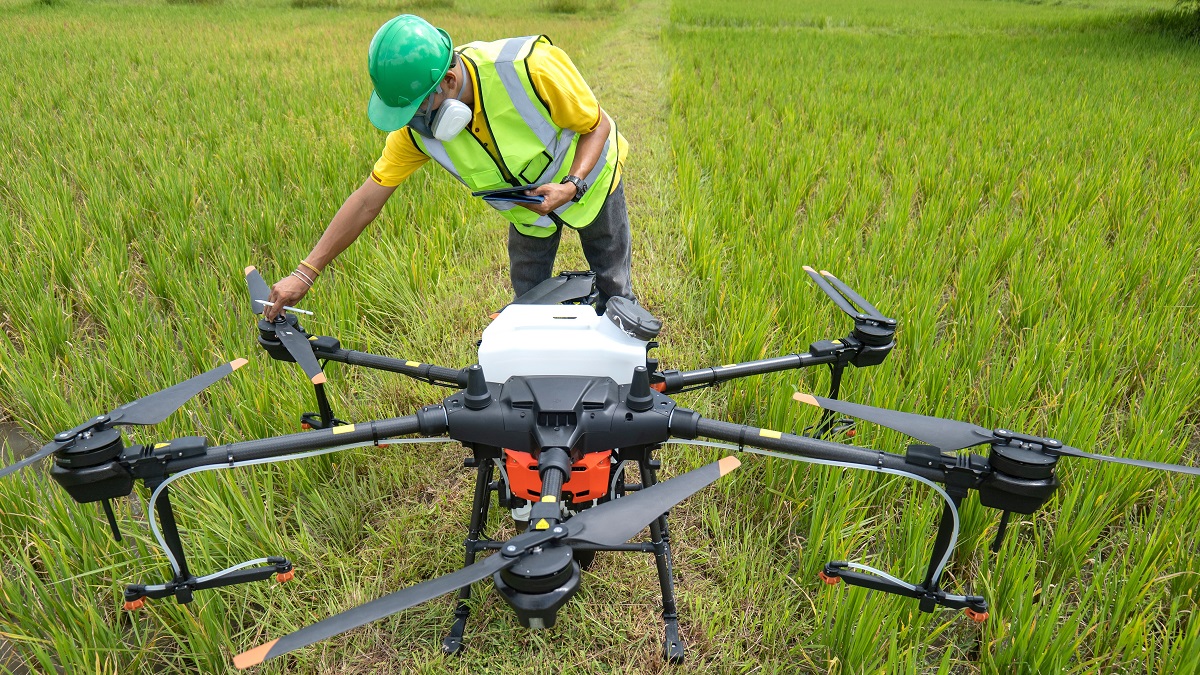An UNCTAD-backed programme helps countries in the global South harness science, technology and innovation to boost crop yields and farming resilience.

© Shutterstock/Srijaroen | Advanced technologies including satellite remote sensing and drone-powered data solutions help increase agricultural efficiency and productivity.
In 2022, heavy rains and severe floods ravaged Nigeria, damaging thousands of hectares of land. The country’s annual maize and rice production fell by an estimated 12% and 21%, respectively.
With such destructive weather events on the rise globally, Nigeria – home to more than 200 million people – is turning to technology to better prepare its farmers and agricultural sector. It has found satellite-based crop monitoring solutions particularly useful.
Africa’s most populous nation is part of the CropWatch innovation cooperation programme launched in 2021 by UNCTAD, the Chinese Academy of Sciences, and the Alliance of International Science Organizations – a non-profit and non-governmental entity.
“Stable crop monitoring using remote sensing data provides powerful information for planning and significantly improves the quality, efficiency and technical depth of decision-making in our agricultural sector,” said Rakiya Babamaaji, an assistant director at Nigeria’s national space research and development agency (NASRDA).
Nigerian experts trained through the programme are customizing the CropWatch platform to the local context. The system uses satellite data to monitor crop growth and other climate-related conditions, such as biomass, temperature and precipitation, to improve farm management.
“The technology and skills acquired through CropWatch will complement the Nigerian government’s efforts to revive the agricultural sector,” said Ms Babamaaji, who works in NASRDA’s natural resources management division.
Powerful tool by and for developing countries
Earth observation and crop monitoring technologies hold huge potential for agriculture, but using them – especially on a massive scale – can be challenging and costly for developing nations.
The CropWatch programme harnesses the power of South-South cooperation to overcome many of the hurdles. It allows participating countries to access much-needed technology, along with training on adapting the system to specific local requirements.
“Through training and hands-on practice, pilot countries can do the monitoring by using the CropWatch platform, without additional investment on storage and computation in the long run,” said Bingfang Wu, a professor at the Chinese Academy of Science.
The programme currently bolsters agricultural monitoring in 14 developing countries across Asia and Africa, accelerating progress towards zero hunger – a key ambition outlined in the UN Sustainable Development Goals.
The work was the result of discussions at the United Nations Commission on Science and Technology for Development (CSTD), to which UNCTAD provides substantive support.
“South-South cooperation in science, technology and innovation is extremely important, as developing countries often share similar development aspirations and challenges,” Shamika N. Sirimanne, UNCTAD’s director of technology and logistics, said at the CSTD's 26th annual session in late March.
“Technologies emerging from developing countries, such as the CropWatch system, can be more appropriate to the local conditions and low resource settings of other developing countries,” Ms Sirimanne added.
Enhancing agricultural resilience for self-sufficiency
Another country that’s part of the programme is Mauritius, a small island developing nation that imports 75% of its food.
To ensure food security, the country seeks to urgently boost local agriculture production and must overcome challenges from a changing climate that has brought more droughts, flash floods and cyclones in recent years.
Mauritius uses CropWatch to help enhance early warning mechanisms, quickly assess crop damage after a disaster and get assistance to affected farmers. The system also helps the country trade more strategically thanks to the data it gathers on the supply of and demand for different crops.
“This will mitigate price fluctuations due to erratic supply on the market and reduce food waste in case of surplus production,” said Micheline Seenevassen Pillay, chief executive officer of Mauritius’ food and agricultural research and extension institute.
“Moreover, with storage and distribution improvements, Mauritius will be able to reduce its food import bills.”
Looking forward
Two regional workshops are planned for 2023 – in Mauritius in July and China in November. They will gather from participating countries policymakers, scientists and technical experts aspiring to tap satellite technology for agricultural transformation.
More information is available online for countries that are interested in joining the programme.



